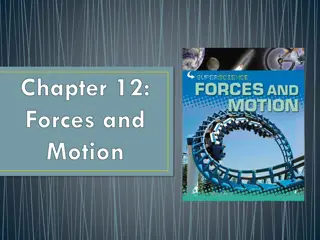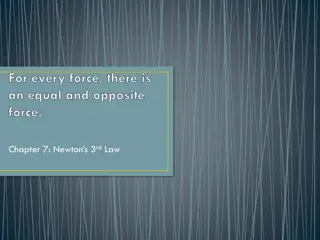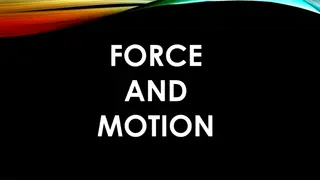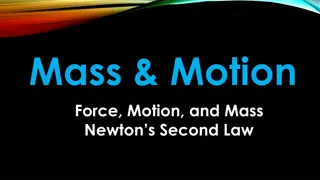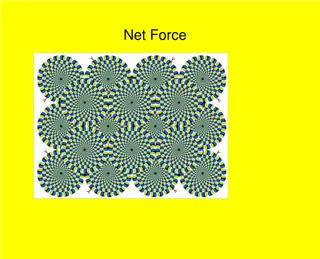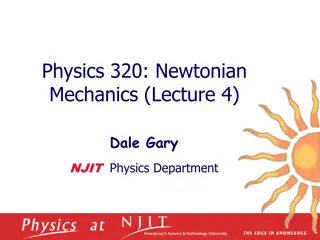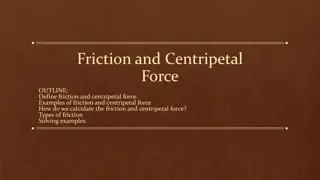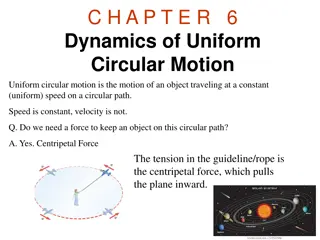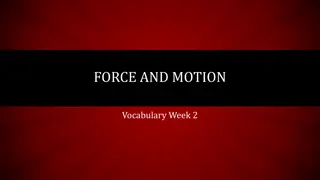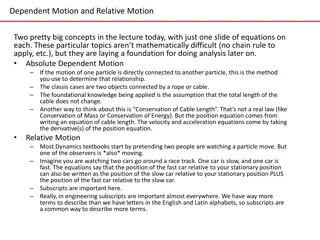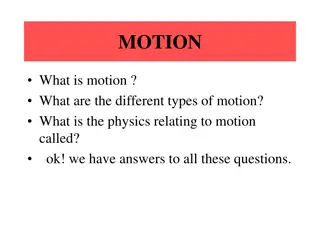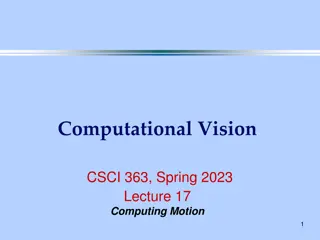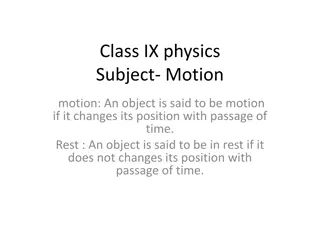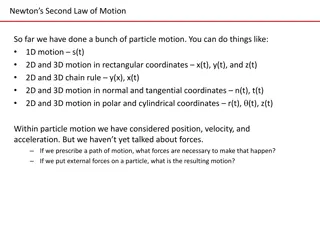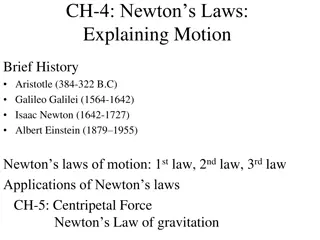Understanding Forces and Motion in Physics
Exploring the concepts of forces and motion, this content delves into the fundamental aspects of how forces impact objects' movement. Covering topics such as measuring force, representing force as a vector, combining forces through addition and subtraction, and understanding balanced and unbalanced
2 views • 61 slides
Understanding Projectile Motion: Characteristics, Examples, and Formulas
Projectile motion involves the motion of objects under the influence of gravity, with both vertical and horizontal components. This type of motion is seen in activities such as throwing a ball, kicking a football, or dropping objects. The motion is described by specific formulas, including calculati
1 views • 19 slides
Understanding Newton's Third Law of Motion
Chapter 7 delves into Newton's Third Law, stating that every force has an equal and opposite force. The law describes the relationship between forces in an interaction - one force being the action force and the other the reaction force. These forces are equal in strength, opposite in direction, and
0 views • 9 slides
Understanding Newton's First Law of Inertia
Newton's first law of inertia states that objects remain at rest or in uniform motion unless acted upon by an external force. This law, also known as the law of inertia, explains how objects tend to maintain their current state of motion unless influenced by an external force. Objects at rest stay a
0 views • 14 slides
Understanding Motion: Frames of Reference and Relative Motion
Motion is defined as a change in position over time. To describe motion accurately, one needs to understand frames of reference and relative motion. Frames of reference are systems of objects used to determine if something is in motion, while relative motion involves movement in relation to a refere
3 views • 14 slides
Understanding Motion: Concepts and Definitions in Physics
Motion in physics is defined as the change in position of an object over time. It involves concepts like rest, motion, distance, displacement, rate of motion, and types of motion. Rest and motion are relative to a reference point, while distance and displacement differ in their scalar and vector nat
2 views • 25 slides
Understanding Force and Motion in Science
Explore the concepts of force and motion in this educational content. Dive into topics like position, reference points, distance, and measuring motion. Understand the basics of motion and how it relates to everyday experiences, such as traveling from home to school. Enhance your knowledge of these f
2 views • 16 slides
Understanding Mass, Motion, and Force According to Newton's Second Law
Explore the relationship between mass, motion, and force through Newton's Second Law. Learn how the mass of an object affects the force required to change its motion, illustrated with examples like hitting different balls with the same force and pulling a wagon empty vs. loaded. Dive deeper into the
0 views • 10 slides
Understanding Net Force in Physics
Explore the concept of net force in physics, including balanced and unbalanced forces, the relationship between force and motion, and how net force affects an object's movement. Learn about scenarios where net force is zero, one force acts on an object, multiple forces cancel out, or combine to prod
0 views • 11 slides
Understanding Newton's Laws of Motion
Newton's laws of motion, formulated by Sir Isaac Newton, describe the interactions between forces and motion of massive bodies. The three laws cover inertia, force, acceleration, and action-reaction pairs, providing the foundation for understanding motion in various scenarios.
0 views • 11 slides
Understanding Newton's Laws of Motion and Law of Universal Gravitation
Isaac Newton, a giant in scientific history, revolutionized physics with his three laws of motion and law of universal gravitation. His laws of inertia, force, and action and reaction explain the behavior of objects in motion, while the law of gravitation describes the force that governs celestial b
3 views • 10 slides
Understanding Linear and Rotational Motion in Physics
Explore the concepts of linear momentum, center of mass, rotational motion, and angular displacement in physics. Learn how to determine the center of mass of objects, analyze motion of particle groups, and understand the conservation of momentum in systems under external forces. Delve into the funda
0 views • 18 slides
Understanding Circular Motion in Physics
Circular motion involves objects moving in a circular path at a constant speed, experiencing acceleration and centripetal force. This motion is characterized by angular speed, centripetal acceleration, and the necessary centripetal force. The concept of uniform circular motion and angular displaceme
3 views • 38 slides
Understanding Newton's Third Law of Motion
The Third Law of Motion states that for every action, there is an equal and opposite reaction. This law is demonstrated through various examples in everyday life, such as pushing against a wall, jumping on a trampoline, or how rockets work. Momentum, the product of an object's mass and velocity, pla
0 views • 10 slides
Understanding Newton's Laws of Motion
Explore Newton's Laws of Motion including the concepts of force, inertia, acceleration, action and reaction forces, and the role of mass in determining motion. Newton's First Law states that objects at rest remain at rest unless acted upon by an unbalanced force. Newton's Second Law relates accelera
0 views • 16 slides
Understanding Friction and Centripetal Force in Physics
Friction is the force that opposes the motion of objects, while centripetal force is essential for circular motion. Types of friction include static, sliding, rolling, and fluid friction. We calculate friction and centripetal force using specific formulas. Examples like walking and writing illustrat
0 views • 18 slides
Understanding Newton's Laws of Motion
Explore Sir Isaac Newton's foundational principles of motion through engaging visuals and real-world examples. Discover how inertia, force, and acceleration shape the dynamics of objects in motion, as explained by Newton's First and Second Laws. Delve into the concept of inertia and the relationship
2 views • 13 slides
Understanding Newton's First Law of Motion
Exploring the foundational concepts of motion and forces, this content delves into Isaac Newton's First Law of Motion. Describing how objects behave when the net force acting on them is zero, the law highlights the significance of inertia and balanced forces in determining an object's state of rest
0 views • 9 slides
Understanding Balanced and Unbalanced Forces in Physics
Forces play a crucial role in determining an object's motion. Balanced forces have a net force of 0 N, resulting in no change in motion, while unbalanced forces lead to a change in motion. Inertia, the resistance to changes in motion, and the concept of combining forces are also important in underst
2 views • 30 slides
Understanding Newton's Laws of Motion
Newton's laws of motion, including the principles of inertia and dynamics, explain how objects move and interact with forces. The first law states that objects in motion remain in motion unless acted upon by a force, while the second law explains how a net force is required to change an object's vel
0 views • 21 slides
Understanding Forces and Mass
Forces, such as contact and non-contact forces, interact with objects to cause motion or deformation. Mass is the amount of matter in an object, measured in kilograms. Learn about applied force, normal force, frictional force, air resistance, spring force, tensile forces, compressive forces, and she
1 views • 29 slides
Understanding Vertical Motion and Gravity in Kinematics
Explore the principles of vertical motion and gravity in kinematics through scenarios involving throwing objects, free-fall motion, and calculating heights. Learn how to model vertical motion with acceleration due to gravity, find maximum heights of thrown objects, solve extended problems, and under
2 views • 12 slides
Understanding Newton's Laws of Motion
Explore the fundamental concepts of Newton's Laws of Motion, including net forces, combining forces, balanced versus unbalanced forces, and the concept of inertia. Learn how these principles explain the behavior of objects in motion and at rest, and discover the impact of mass on an object's resista
0 views • 17 slides
Understanding Joint Motion: Osteokinematic and Arthrokinematic Movements
Joint motion involves osteokinematic movements, which are under voluntary control and include flexion, extension, and more. End-feel sensations like bony, capsular, and springy block indicate different joint conditions. Arthrokinematic motion refers to how joint surfaces move during osteokinematic m
0 views • 17 slides
Understanding Newton's Laws of Motion
Newton's Laws of Motion explain the relationship between forces and motion. The first law states that an object in motion stays in motion unless acted upon by a net force, while the second law describes how force is related to an object's mass and acceleration. The third law states that for every ac
0 views • 21 slides
Understanding Newton's Laws of Motion
Dynamics is governed by Newton's three fundamental laws of motion. These laws, formulated by Newton, describe the behavior of objects in motion and at rest. Key terms such as mass, weight, momentum, force, and inertia are crucial in understanding these laws. Rigid bodies, which consist of fixed part
0 views • 22 slides
Understanding Newton's Laws of Motion: Inertia, Forces, and Acceleration
Delve into the fundamentals of Newton's first and second laws of motion, exploring concepts such as inertia, the relationship between forces and acceleration, and the procedure for solving force problems. Discover how objects behave when left to themselves, and grasp the significance of forces in ch
0 views • 21 slides
Understanding Robbery: Elements, Definition, and Distinctions
Robbery, defined under Section 8 of the Theft Act 1968, involves the act of stealing with the use of force or threat of force. This offense carries serious consequences, including a potential life imprisonment sentence. The key elements of robbery include the actus reus of theft and force, along wit
0 views • 11 slides
Understanding Newton's Laws of Motion
Newton's Laws of Motion describe how objects behave in response to external forces. The first law states that objects in motion remain in motion unless acted upon by a force, while objects at rest stay at rest. The second law relates force, mass, and acceleration, showing how they are interconnected
0 views • 11 slides
Understanding Dynamics of Uniform Circular Motion
Exploring the concept of uniform circular motion, this content delves into the centripetal force required to keep an object moving at a constant speed along a circular path. It discusses the relationship between centripetal force, speed, radius, and mass in maintaining circular motion. Various examp
0 views • 13 slides
Understanding Force and Motion: Key Concepts and Examples
Explore the fundamental concepts of force and motion, including balanced and unbalanced forces, gravity, inertia, friction, Newton's laws, and the unit of force (Newton). Discover how these concepts influence the behavior of objects and their motion through engaging examples and explanations.
0 views • 15 slides
Understanding Motion and Newton's Laws
Explore the concepts of motion, distance, speed, and velocity as they relate to Newton's Laws of Motion. Learn about measuring motion, calculating speed, graphing motion on distance-time graphs, and understanding velocity. Discover how motion is constant and how relative motion is used. Practice cal
0 views • 36 slides
Understanding Motion and Newton's Laws
Motion is the constant change in position of objects, measured by distance and displacement. Speed is the rate of motion, while velocity includes direction. Graphing motion helps visualize speed changes over time. Newton's Laws explain the behavior of objects in motion.
0 views • 38 slides
Understanding Dependent and Relative Motion in Dynamics
Dependent Motion and Relative Motion are fundamental concepts in Dynamics, providing the foundation for future analysis. Dependent Motion involves constraints like ropes or cables, while Relative Motion considers observers in motion. Dynamics involves applying a limited set of equations in diverse w
0 views • 18 slides
Understanding Motion: Types and Physics
Motion refers to a body changing position with respect to its surroundings. Different types of motion include linear, rotatory, and oscillatory motion. The physics relating to motion is called Mechanics, which comprises Dynamics and Kinematics. Scalars and vectors play a crucial role in describing t
0 views • 8 slides
Understanding Robbery: Elements and Distinctions
Robbery, as defined in Section 8 of the Theft Act 1968, involves the act of stealing accompanied by the use of force or the threat of force to instill fear in order to commit the theft. This offense is considered more serious than theft and can lead to a life imprisonment sentence. The key elements
0 views • 11 slides
Understanding Motion Perception in Computational Vision
In computational vision, the concept of motion opponency plays a crucial role in how the brain processes left and right motion inputs. By examining psychophysical results and the construction of motion opponent energy filters, we explore how the brain handles motion information. Additionally, the Ve
0 views • 23 slides
Understanding Motion in Physics: Definitions and Examples
An object is said to be in motion if it changes position with time, while rest implies no change. Learn about types of motion such as linear and circular, as well as vibratory motion and reference points. Explore how objects can be in motion relative to one reference point while at rest relative to
0 views • 4 slides
Understanding Newton's Second Law of Motion
Exploring Newton's Second Law of Motion which states that an unbalanced force acting on a particle causes acceleration proportional to the force. The law is expressed as F=ma, highlighting the relationship between force, mass, and acceleration. Additionally, the concept of gravitational attraction a
0 views • 15 slides
Evolution of Motion Theories: Aristotle to Einstein
Explore the progression of motion theories from Aristotle's belief in a force for motion to Galileo's discoveries on gravity, Newton's laws of motion, and Einstein's theories of relativity and quantum mechanics. Discover how our understanding of motion has evolved over the centuries, shaping the way
0 views • 20 slides
